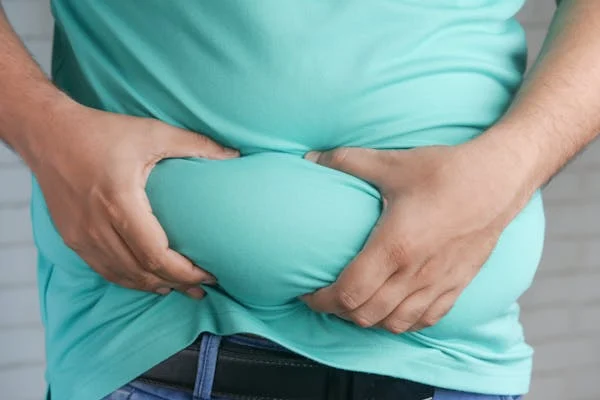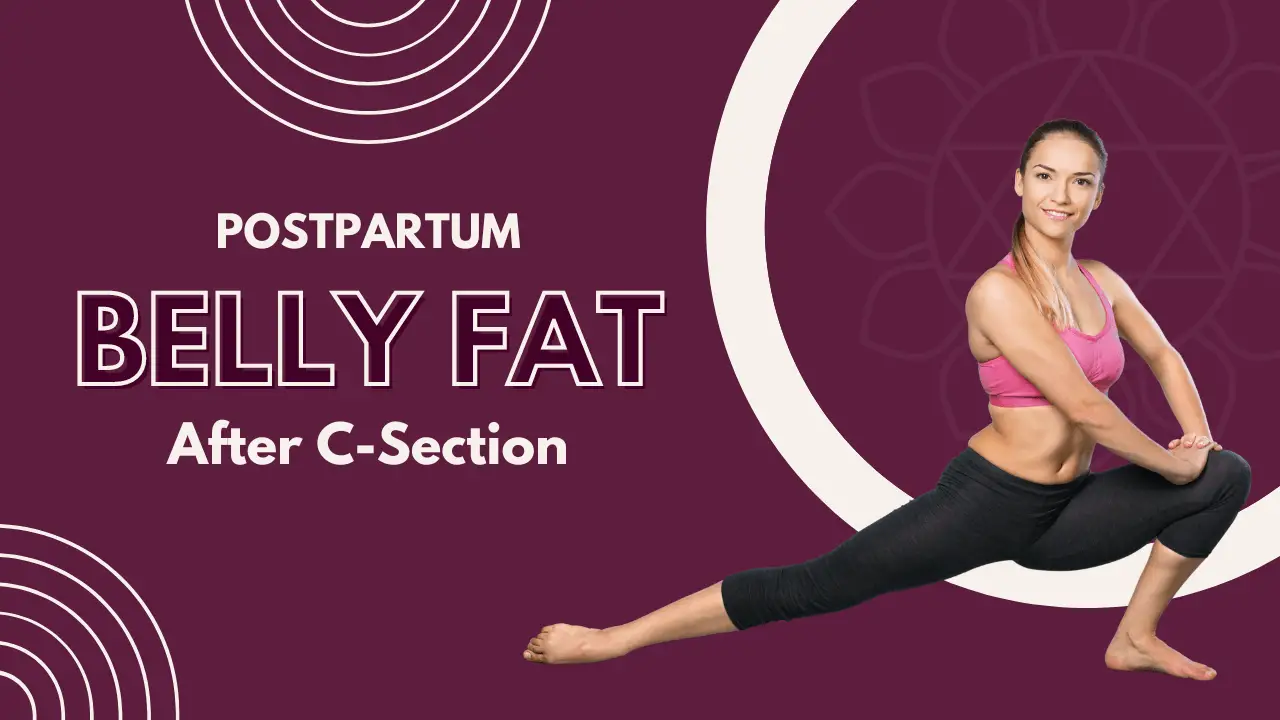It can be difficult to recuperate from childbirth, particularly when it comes to dealing with particular issues like how to lose postpartum belly fat after C-section. This procedure is distinct and frequently more difficult because of the combination of surgery and the physiological changes that occur after childbirth.
To guarantee the health of the mother and the child, it is imperative that this aim be approached with an emphasis on safe and efficient techniques. Regaining their pre-pregnancy body and recovering from the C-section are two challenges that many new mothers must overcome.

Understanding how to lose postpartum belly fat after C-section involves a combination of gentle exercises, proper nutrition, and adequate rest. This blog post will provide comprehensive insights and practical advice to help new mothers embark on a healthy and successful journey towards losing postpartum belly fat, all while prioritizing their recovery and overall health.
Postpartum Body Changes:
After giving birth via C-section, a woman’s body undergoes numerous changes as it recovers from both pregnancy and surgery. These changes can affect the approach to losing postpartum belly fat. Understanding these changes is essential for devising a safe and effective plan to address concerns like how to lose postpartum belly fat after C-section.
Hormonal Shifts
Hormonal changes after childbirth are important. Following birth, levels of progesterone and estrogen, which were raised throughout pregnancy, sharply decline. These hormonal shifts can impact mood, energy levels, and metabolism, making weight reduction more difficult.
Furthermore, hormones like relaxing, which the body continues to produce for several months after giving birth, might affect joint flexibility and stability, necessitating cautious exercise selection.
Abdominal Muscle Separation
The abdominal muscles expand to make room for the growing baby during pregnancy. This may result in a separation of the right and left sides of the rectus abdominis muscle, a disease called diastasis recti.
This division may weaken the core and give the abdomen a bloated appearance. It is essential to treat diastasis recti in order to safely lose tummy fat after giving birth. It is crucial to perform specific exercises designed to close the gap and strengthen the core muscles.
Surgical Recovery
Recovery from a large abdominal surgery like a C-section entails healing from both the internal wounds and the incision. Physical activity may be restricted during recovering, which can take many weeks to months.
Mobility and exercise regimens might also be impacted by pain and discomfort in the area of the incision. To prevent difficulties, it is essential to heed medical recommendations and increase exercise levels gradually.
Metabolism and Fat Distribution
The body may store fat differently after giving birth, with the abdomen having a propensity to hold onto fat. This is partially brought on by hormone fluctuations and partially by the body’s innate tendency to reserve energy for healing and nursing. Setting reasonable expectations and goals for reducing abdominal fat is made easier by being aware of this transition.
When learning how to reduce postpartum belly fat after a C-section, navigating these postpartum body changes is essential. New mothers can design a complete and successful strategy to reach their fitness objectives by recognizing and managing hormonal fluctuations, muscle separation, surgical recuperation, and changes in metabolism.
How to Lose Postpartum Belly Fat After C-Section:
Losing postpartum belly fat after a C-section requires a tailored approach that considers both the surgical recovery and the body’s natural postpartum changes. The primary focus should be on gentle yet effective methods that promote healing while gradually reducing belly fat.
Gentle Exercises for Initial Recovery
In the early weeks following a C-section, the body needs time to heal. Start with gentle exercises like walking and deep breathing exercises. Walking helps improve circulation, boosts mood, and starts the process of burning calories. Deep breathing exercises, combined with abdominal contractions, can help engage the core muscles without putting undue strain on the incision site.
Gradual Progression to More Intense Workouts
As your body continues to heal and you get clearance from your doctor, you can gradually introduce more intense workouts. These might include pelvic tilts, leg slides, and modified planks. Incorporating strength training can help build muscle, which in turn boosts metabolism and aids in fat loss.
Specific Exercises Targeting Belly Fat
Core-focused activities are necessary to target abdominal fat. Since they are easy on the body and emphasize stability and strength in the core, Pilates and yoga are great options. Incorporating exercises like side planks, bridges, and sitting ball stability exercises can also assist tone of the abdominal region.
These must be used in conjunction with full-body exercises to guarantee balanced muscle growth and fat reduction. The key to understanding how to reduce postpartum belly fat following a C-section is to combine a comprehensive approach to health and fitness with gradual, mild exercise.
With this approach, new moms can reach their fitness objectives without sacrificing their recuperation or general wellbeing.
Safe and Effective Exercise Methods
Adopting safe and effective exercise methods is crucial for new mothers looking to lose postpartum belly fat after a C-section. The focus should be on gradual progression and exercises that promote healing while effectively targeting belly fat. Here’s how to approach it:
Gentle Exercises for Initial Recovery
In the initial weeks after a C-section, the body needs time to heal from the surgery. Gentle exercises are essential to start with to avoid putting strain on the incision site. Walking is highly recommended as it boosts circulation, aids in recovery, and gently burns calories.

Additionally, practicing deep breathing exercises with gentle abdominal contractions can help re-engage the core muscles without causing stress to the healing area.
Gradual Progression to More Intense Workouts
Gradually introducing more rigorous workouts becomes possible after the initial healing phase and with the doctor’s agreement. Begin with low-impact workouts such as modified planks, leg slides, and pelvic tilts.
These workouts enhance general fitness and strengthen the core. More difficult exercises like lunges, squats, and resistance training can be added as strength and endurance increase to improve muscle tone and fat loss even more.
Specific Exercises Targeting Belly Fat
Exercises that work the core muscles are key to efficiently targeting abdominal fat. For this reason, Pilates and yoga are great since they focus on stability, flexibility, and strength of the core while being easy on the body.
Furthermore, the abdominal region can be especially targeted by workouts like side planks, bridges, and sitting ball stability exercises. These core-specific exercises must be done in conjunction with full-body workouts to guarantee balanced muscle growth and general fat loss.
Using safe and efficient workout techniques is essential to learning how to reduce belly fat after a cesarean section. New mothers can reach their fitness objectives without sacrificing their recuperation and general well-being by beginning with mild exercises, progressively upping the intensity of their workouts, and incorporating core-targeted routines.
Nutrition Tips for Postpartum Weight Loss :
Nutrition plays a crucial role in postpartum weight loss and belly fat reduction after a C-section. Here are some key dietary tips:

- Prioritize whole foods: Focus on consuming fruits, vegetables, whole grains, and lean protein sources. These foods are rich in nutrients that support healing, promote satiety (feeling full), and aid in weight management.
- Limit processed foods: Processed foods are often high in unhealthy fats, added sugars, and sodium, which can hinder weight loss efforts. They tend to be lower in nutrients and fiber, leaving you feeling hungrier sooner.
- Stay hydrated: Drinking plenty of water helps flush toxins, keeps you feeling full, and aids in digestion. Strive to drink eight glasses of water daily, adjusting for your activity level and the climate.
- Don’t skip meals: Aim for regular meals and snacks throughout the day to maintain your metabolism and prevent overeating at later meals. This will help regulate your blood sugar levels and keep you energized throughout the day.
- Consider breastfeeding: Breastfeeding burns calories and helps your uterus shrink back to its pre-pregnancy size. It also promotes the release of oxytocin, a hormone that aids in abdominal muscle contraction.
The Role of Sleep:
Adequate sleep is a crucial factor in the journey of losing postpartum belly fat after a C-section. Quality sleep supports overall health, aids recovery, and plays a significant role in weight loss.
Importance of Sleep for Recovery
Sleep is essential for the body to repair and heal, especially after a C-section. During deep sleep, the body releases growth hormones that promote tissue repair and muscle growth, which are vital for recovering from surgery and physical strain.
Sleep and Weight Loss
Lack of sleep can negatively impact metabolism and increase the production of cortisol, a stress hormone that can lead to weight gain, particularly around the abdomen. Getting enough rest helps regulate hunger hormones like ghrelin and leptin, which control appetite and satiety, making it easier to avoid overeating.
Tips for Better Sleep
Establishing a bedtime routine, making a calm sleep environment, and, if possible, getting assistance with nocturnal feedings are all ways that new mothers can enhance the quality of their sleep. Improved sleep quality can also come from letting the infant nap when they sleep and limiting coffee and screen time before bed.
New mothers can make better decisions about how to reduce postpartum belly fat following a cesarean section, assuring a healthier and more successful outcome, by being aware of the importance of sleep in their recuperation and weight reduction journey.
Tips for Staying Consistent and Motivated:
Losing belly fat after a C-section is a marathon, not a sprint. Here are some tips to stay consistent and motivated on your journey:
- Set realistic goals: Don’t aim for drastic weight loss right away. Focus on small, achievable goals, like walking for 30 minutes three times a week or adding a serving of vegetables to each meal.
- Choose an exercise routine you enjoy: If running isn’t your thing, don’t force it. Try activities like swimming, prenatal yoga, or dancing. Enjoyable workouts are more likely to become a lasting habit.
- Make it a family affair: Involve your partner and family in your healthy lifestyle changes. Go for walks together, cook healthy meals as a family, and find ways to be active together. Their support can be a huge motivator.
- Track your progress: Journaling your food intake, recording your workouts, or taking progress photos can help you visualize your achievements and stay accountable.
- Don’t be afraid to ask for help: Whether it’s from a healthcare professional, a registered dietitian, or a certified personal trainer, seeking guidance can keep you on track and address any challenges you face.
- Focus on progress, not perfection: There will be setbacks and cheat days. Don’t let them derail your entire journey. Get back on track with your next meal or workout, and remember, consistency is key.
Conclusion:
After a C-section, losing postpartum belly fat necessitates a comprehensive strategy that combines mild activity, healthy eating, enough sleep, and persistent motivation. Resolving postpartum belly fat following a cesarean section necessitates understanding the particular difficulties associated with surgical recovery and hormonal fluctuations.
New mothers can safely and successfully reach their fitness objectives by using a positive mindset, setting realistic goals, and getting support. Making health and well-being a priority guarantees a successful path to postpartum recuperation and fitness. Click to learn more.
FAQs:
- Can I start exercising immediately after a C-section? It’s essential to wait until you receive medical clearance from your doctor, typically around 6-8 weeks postpartum, before beginning any exercise routine.
- What are the best exercises to start with after a C-section? Begin with gentle exercises such as walking and deep breathing exercises. Gradually progress to more intense workouts like pelvic tilts and modified planks as you heal.
- How can I maintain motivation to lose postpartum belly fat? Set realistic goals, celebrate small milestones, find a support system, and focus on activities you enjoy to stay motivated.
- What foods should I include in my diet to lose postpartum belly fat? Incorporate lean proteins, whole grains, fruits, vegetables, and healthy fats into your diet while avoiding processed foods and excessive sugar.
- How important is sleep in losing postpartum belly fat after a C-section? Adequate sleep is crucial as it supports recovery, regulates metabolism, and helps control hunger hormones, aiding in weight loss.
